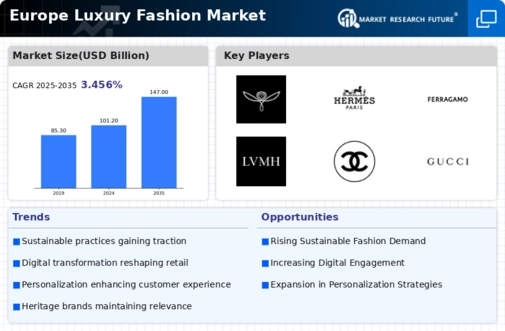The Europe Luxury Fashion Market represents a vibrant and diverse sector characterized by its longstanding heritage, exclusivity, and artisan craftsmanship. In a dynamic competitive landscape where consumer preferences continuously evolve, brands are constantly innovating to capture market share. Key elements defining this competitive environment include shifts toward sustainability, digitalization, and the increasing influence of social media on brand perception and consumer engagement. Established luxury labels face the challenge of navigating these complex market dynamics while maintaining brand loyalty and prestige.
As the demand for luxury goods rises, particularly among younger consumers who prioritize experiential purchases and ethical considerations, brands must strategically position themselves to capitalize on these trends, leveraging market insights and consumer data to refine their offerings. The Europe Luxury Fashion Market remains a significant driver of growth and innovation within the global sector, showcasing a mix of heritage brands and burgeoning talents that together reshape the fashion landscape.In the context of the European Luxury Fashion Market, Burberry stands out with its strong brand identity built around British heritage and innovation in luxury outerwear.
The brand’s iconic trench coat symbolizes classic elegance while appealing to contemporary fashion sensibilities. Burberry's commitment to digital transformation is evident through its effective use of social media and e-commerce platforms, engaging younger consumers while retaining its prestigious image. The company’s focus on sustainability and responsible luxury has further reinforced its position in the European market, enabling it to attract a loyal customer base that values ethical practices.
Burberry's strategic partnerships and collaborations with other luxury entities have enhanced its visibility and market presence, allowing it to maintain a competitive edge amid the fast-paced nature of fashion trends and consumer demands.Kering has established a formidable presence in the Europe Luxury Fashion Market through its diverse portfolio of luxury brands. The company operates several high-profile fashion houses known for their exclusive products, ranging from haute couture clothing to coveted accessories and leather goods. Kering's strength lies in its ability to cultivate brand dynamism while leveraging synergies across its various labels, thereby enhancing market efficiency and consumer engagement.
The company is actively involved in promoting sustainability within the luxury fashion sector, which resonates well with increasingly conscientious consumers. Through strategic mergers and acquisitions, Kering has expanded its reach and capabilities in the region, ensuring continued relevance in a competitive landscape. Key initiatives within Kering emphasize innovation in product offerings and sustainable practices, positioning the company as a leader in luxury fashion while tapping into emerging market trends that align with modern consumer values. This holistic focus on brand development, sustainable practices, and expansion initiatives underscores Kering's competitive positioning in the ever-evolving European luxury landscape.

























Leave a Comment